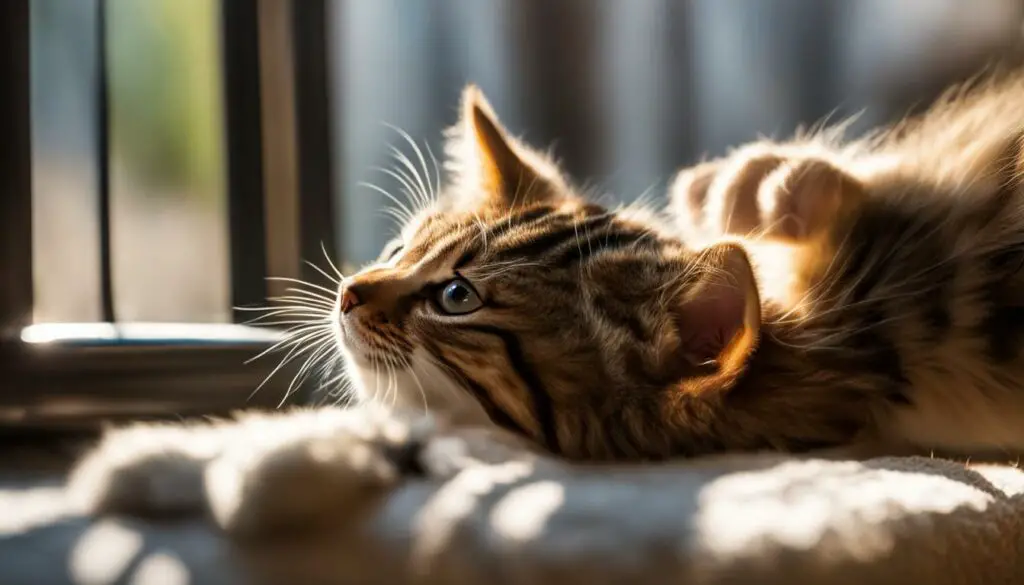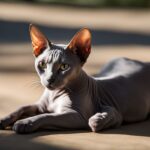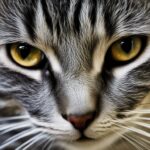Have you ever wondered why your cat seems to have a fascination with playing with your hair? It’s a common behavior in cats and can often leave pet owners curious about its underlying reasons. In this guide, I will delve into the world of cat behavior and explore the various factors that contribute to why cats engage in hair play.
Cat behavior is a fascinating subject, and understanding the reasons behind why your cat plays with your hair can help deepen your bond and enhance your relationship. From grooming habits to social bonding, cats have their unique ways of expressing themselves and interacting with their human companions.
Key Takeaways:
- Cats play with human hair as a way to strengthen the bond between them and their owners.
- Grooming behavior is an important aspect of cat behavior, and hair play is a manifestation of this instinct.
- Understanding cat behavior can help pet owners create a harmonious and enjoyable environment for their feline friends.
- It is essential to ensure the safety and well-being of your cat while allowing them to engage in hair play.
- Embracing your cat’s unique quirks and behaviors can enhance the bond between you and your furry companion.
Terrific Tongues: The Fascinating Anatomy of a Cat’s Tongue
When it comes to grooming, cats have a secret weapon – their tongues. A cat’s tongue is truly unique and fascinating, equipped with specialized features that enable them to effectively groom themselves and remove dirt, loose hairs, and parasites. So, what makes a cat’s tongue so special? Let’s take a closer look at the anatomy of a cat’s tongue.
The surface of a cat’s tongue is covered in hundreds of small, backward-facing barbs called papillae. These papillae are made of keratin, the same material that makes up our hair and nails. The barbs give the tongue its rough texture and are incredibly useful for grooming. As cats lick themselves, the barbs catch onto loose hairs, dirt, and debris, helping to remove them from their fur. The barbs also stimulate the cat’s skin and distribute saliva, which acts as a natural conditioner.
The shape of the papillae is another interesting aspect of a cat’s tongue anatomy. The papillae are shaped like scoops and have hollow tips that absorb saliva and distribute it onto the hair coat and skin surface during grooming. This efficient process not only keeps the cat’s fur clean but also helps to regulate body temperature by cooling the skin through evaporation. It’s truly a marvel of nature!
Table:
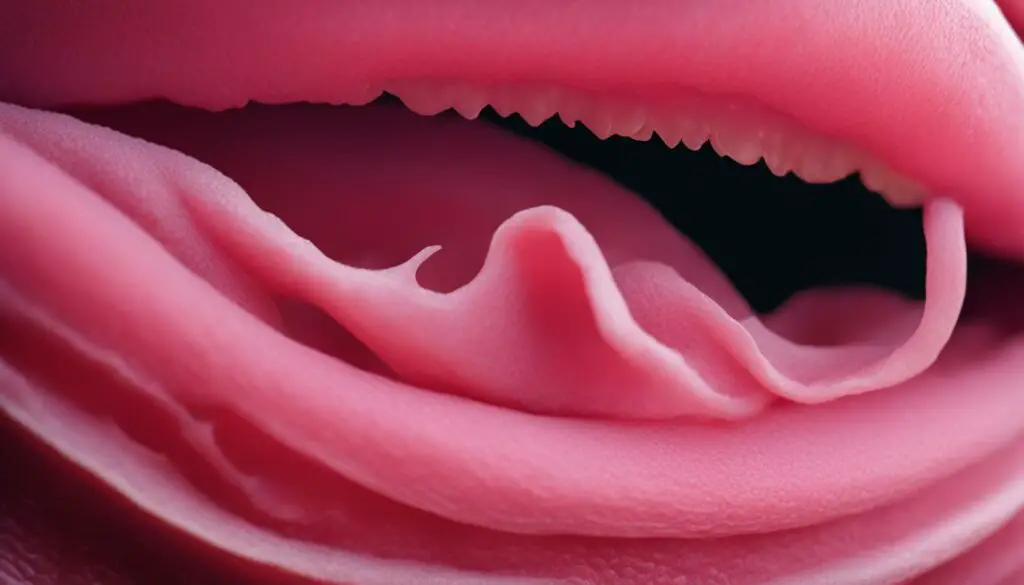
| Papillae Structure | Grooming Function |
|---|---|
| Small, backward-facing barbs | Removes dirt, loose hairs, and parasites from fur |
| Shape like scoops with hollow tips | Distributes saliva onto the hair coat and skin surface, regulates body temperature |
| Keratin composition | Gives the tongue its rough texture, acts as a natural conditioner |
Next time you see your furry friend grooming themselves, take a moment to appreciate their incredible tongue. It’s just another one of the amazing adaptations that make cats such fascinating creatures!
The Importance of Grooming in Cats
Cat grooming is a crucial behavior that serves multiple purposes in their daily lives. Let’s explore why grooming is essential for cats and the various ways they engage in this behavior.
Grooming Behavior
Cats are known for their fastidious grooming habits. They spend a significant amount of time cleaning themselves to maintain a healthy and hygienic coat. This self-grooming helps cats remove dirt, debris, and loose fur from their bodies. It also stimulates the production of natural oils from their skin, which helps keep their fur in good condition.
Social Grooming
Aside from self-grooming, cats also engage in social grooming or allogrooming. This is when cats groom each other as a form of social interaction and bonding. Allogrooming is an important behavior among cats living in the same household, as it helps strengthen their social bonds and maintain a harmonious group dynamic.
Kittens and Grooming
Grooming is especially crucial for kittens. Mother cats groom their kittens to help stimulate their bodily functions, keep them clean, and remove any parasites. This early grooming also plays a role in bonding between the mother and her offspring. As kittens grow, they start to groom themselves and learn the art of grooming from their mother’s example.
| Grooming Habits | Description |
|---|---|
| Self-Grooming | Cats groom themselves to keep their coat clean, remove loose fur, and stimulate the production of natural oils from their skin. |
| Social Grooming | Cats groom each other as a form of social interaction and bonding, helping to strengthen their group dynamics. |
| Kittens Grooming | Mother cats groom their kittens to stimulate bodily functions, keep them clean, and remove parasites, fostering a strong bond. |
“Grooming is not only about physical cleanliness for cats, but it also serves as a way for them to express social bonds and maintain a harmonious group dynamic.”
Grooming is an integral part of a cat’s daily routine. By understanding the importance of grooming in cats, we can appreciate this behavior as a natural and necessary aspect of their lives. Whether it’s self-grooming or social grooming with other cats, grooming plays a vital role in maintaining their overall well-being and strengthening their social connections.
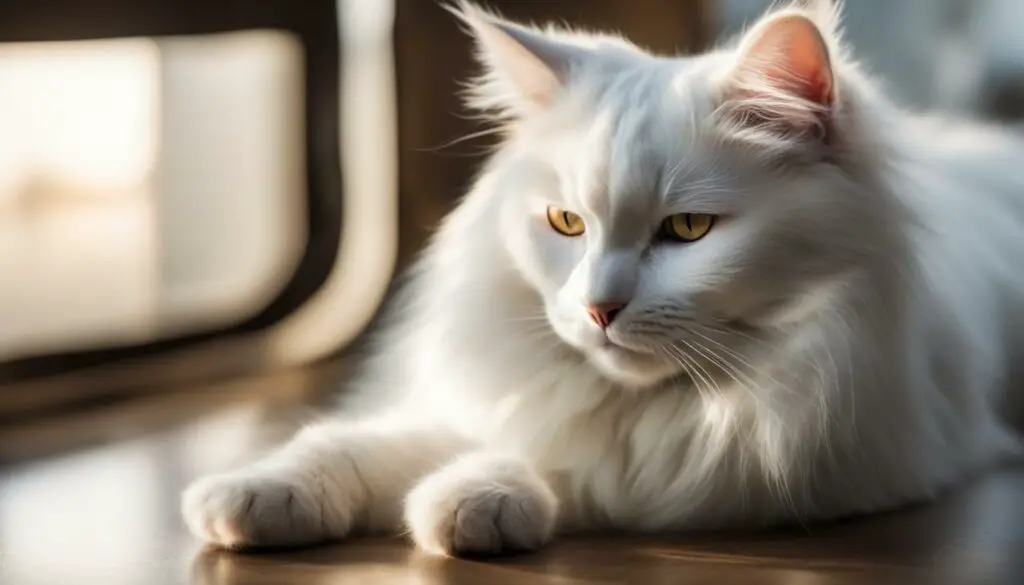
Why Do Cats Groom Each Other?
Cats engage in a behavior known as allogrooming, which involves one cat grooming another. This behavior serves several purposes, including social bonding, scent marking, and friendly interaction among cats.
Allogrooming is a form of social grooming that helps to strengthen the bond between cats. When cats groom each other, they exchange scents, which helps to identify members of their social group. By grooming each other, cats also engage in a friendly interaction that promotes positive social relationships within the group.
In addition to social bonding, allogrooming can also serve as a form of scent marking. Cats have scent glands located on their heads and necks, and by grooming these areas, they deposit their scent on other cats. This scent marking behavior helps to establish territory and communicate dominance within the social group.
It is important to note that allogrooming is different from dominance behavior, although it can sometimes be mistaken for it. Cats engage in allogrooming as a friendly and bonding behavior, rather than a display of dominance or aggression. By grooming each other, cats establish harmonious relationships and maintain a sense of social cohesion within their group.
| Benefits of Allogrooming | Explanation |
|---|---|
| Social bonding | Grooming helps cats strengthen their social bonds and enhance their relationships within the group. |
| Scent marking | Cats deposit their scent on each other through grooming, which helps establish territory and communicate dominance. |
| Friendly interaction | Grooming is a form of friendly interaction that promotes positive relationships and reduces the likelihood of aggression. |
When cats groom each other, it is a sign of friendship and a way for them to show affection. By engaging in allogrooming, cats strengthen their social bonds and establish a sense of harmony within their group.
The Role of Allogrooming in Cat Relationships
Allogrooming plays a crucial role in cat relationships, both within households and among feral cat colonies. It helps to maintain a peaceful and cooperative atmosphere among cats, reducing the likelihood of conflicts and promoting social harmony. By understanding the reasons behind allogrooming, we can gain a deeper appreciation for the complex and fascinating social dynamics of our feline friends.
The Significance of Cat Hair Play with Humans
When your cat engages in hair play with you, it is a beautiful display of bonding and affectionate behavior. Cats often groom the heads and necks of their favorite humans as a way to strengthen their social bond and share their scent. By licking your hair, your cat is not only demonstrating their affection but also marking you as a member of their trusted group.
This hair play behavior is similar to the way cats groom each other within their social group. It creates a sense of familiarity and intimacy between you and your feline companion. In the world of cats, grooming is a significant social interaction that promotes trust and strengthens the human-cat bond.
| Benefits of Cat Hair Play with Humans | SEO Keywords |
|---|---|
| Enhances bonding | cat hair play, bonding with humans |
| Facilitates scent sharing | scent sharing, human-cat interaction |
| Displays affection | affectionate behavior, human-cat interaction |
Moreover, cats may also enjoy the attention and interaction they receive from you when they engage in hair play. They appreciate the connection they feel when you respond positively to their grooming behavior. So the next time your cat starts playing with your hair, embrace it as a way to strengthen the bond between you and your feline friend.
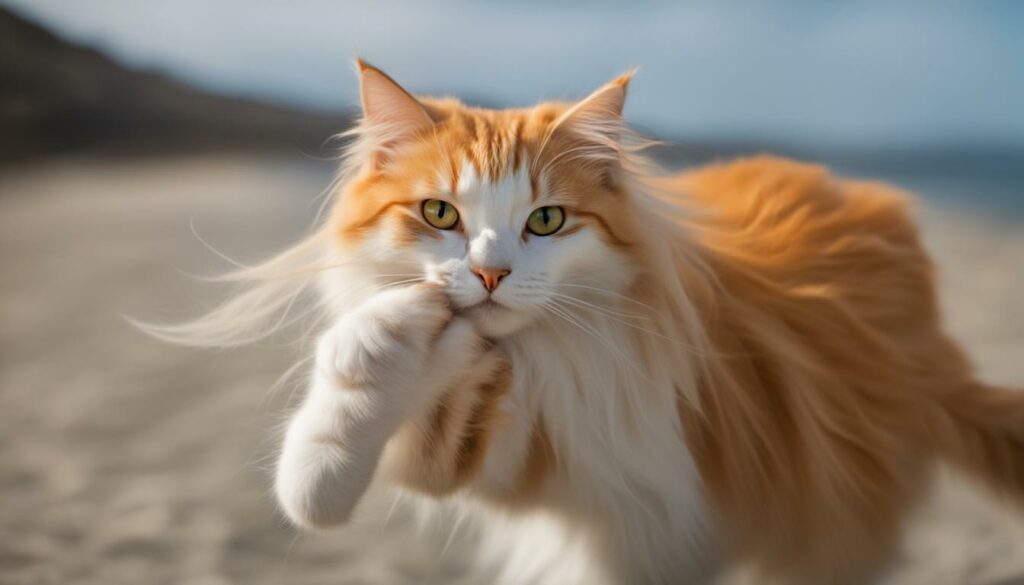
“The bond between a cat and its human is special and unique. Embracing and enjoying the hair play is part of that connection. It’s a joyful experience that deepens our relationship and brings a sense of playfulness into our lives.”
The Various Reasons Why Cats Play with Human Hair
Cats are naturally playful creatures, and their curiosity often leads them to interact with the world around them, including human hair. There are several reasons why cats engage in hair play, and understanding these motivations can help us better appreciate and manage this behavior.
Grooming Behavior: Cats are meticulous groomers, and playing with human hair allows them to practice their grooming skills. They may see your hair as an opportunity to remove loose fur, tangles, and dirt, just as they would with their own coat.
Seeking Attention: Cats are also known for seeking attention and engaging in behaviors that elicit a response from their human companions. Playing with your hair can be a way for them to capture your attention and receive affection or playtime in return.
Prey Instinct: Hair, with its flowing and unpredictable movements, can mimic the behavior of prey animals. Cats have an instinctive drive to chase and capture moving objects, and hair play can satisfy this natural hunting instinct.
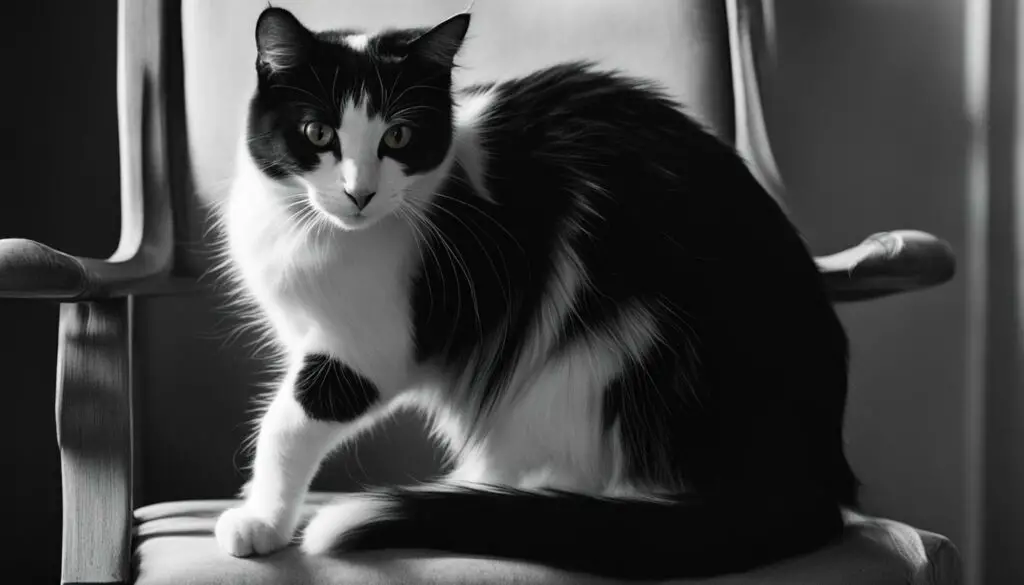
Feline love for textures
Comfort Seeking: The texture of human hair can be soothing for cats. Its softness and warmth can provide a sense of comfort and security, similar to how cats knead soft blankets or cuddle into cozy spots.
Attraction to Strong Smells: Cats have a highly developed sense of smell, and they may be drawn to the scents present in your hair, such as hair products or natural oils. These smells can be intriguing and enticing for them.
In conclusion, cats play with human hair for various reasons, including grooming behavior, seeking attention, prey instinct, comfort seeking, and attraction to strong smells and soft textures. While this behavior can be entertaining and endearing, it’s important to ensure that it remains safe for both you and your feline friend. By providing appropriate alternatives and monitoring their play, you can foster a healthy and enriching environment for your cat.
Is It Safe for Cats to Groom Human Hair?
When cats groom human hair, it generally poses no significant health concerns, as long as they do not ingest the hair or any toxic ingredients from hair or skin products. However, if a cat consumes hair, it can lead to the formation of hairballs in their digestive system, which may require surgical removal. Eating hair could also indicate a rare form of pica, an eating disorder characterized by the ingestion of non-food items. Therefore, it is important to ensure that the products you use on your hair and skin are safe for cats to avoid any potential health risks.
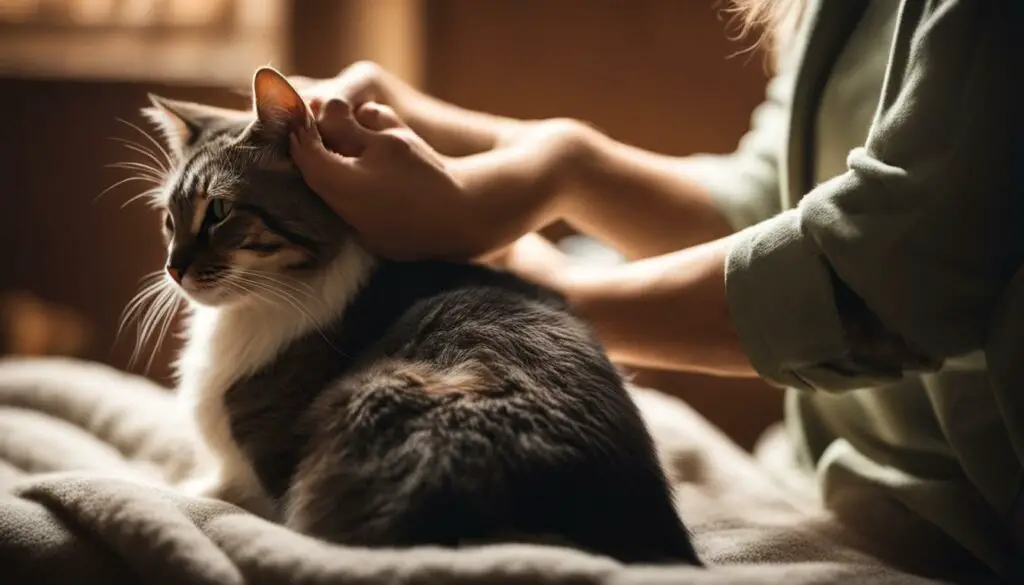
To prevent hair ingestion, it is advisable to monitor your cat’s grooming habits and discourage them from licking or chewing on your hair. Redirecting their attention to appropriate toys or objects can help distract them from hair play. If you notice excessive hair consumption or any changes in your cat’s behavior, it is recommended to consult with a veterinarian for professional guidance and evaluation.
Avoiding punishment or shouting at your cat for grooming your hair is crucial, as it can cause stress and behavioral issues. Instead, focus on providing alternative outlets for their grooming needs and rewarding them for appropriate behavior. By ensuring a safe and enjoyable grooming experience for both you and your cat, you can strengthen your bond and foster a positive relationship.
How to Discourage Cat Hair Grooming
While many cat owners enjoy the sensation of their feline friends grooming their hair, there are some who may not find it as pleasant. If you’re looking to discourage your cat from grooming your hair, there are several strategies you can try.
One approach is to change your hair products. Cats are attracted to certain scents, so opting for products with a different fragrance may help deter them from wanting to groom your hair. Additionally, you can use distraction techniques such as engaging in playtime with your cat or offering them toys to redirect their attention away from your hair.
If changing hair products or using distraction techniques doesn’t work, you can consider ignoring the behavior. Cats often engage in grooming behavior for attention, so by not reacting or acknowledging their grooming attempts, they may eventually lose interest. It’s important to note that punishment should be avoided as it can cause stress and may lead to behavioral issues.
Different Techniques to Discourage Cat Hair Grooming
Providing alternatives is another effective method to discourage cat hair grooming. Offer your cat appropriate toys or objects that they can groom instead. This can include grooming brushes or special cat grooming mitts. By redirecting their grooming behavior to these alternatives, you can satisfy their grooming needs while protecting your hair from unwanted attention.
Remember, every cat is unique, so it may take some trial and error to find the method that works best for your feline companion. Patience, consistency, and positive reinforcement are key. By providing alternatives, distracting your cat, or ignoring the behavior, you can discourage hair grooming in a gentle and effective way.
| Techniques to Discourage Cat Hair Grooming | Effectiveness |
|---|---|
| Changing hair products | Medium |
| Using distraction techniques | High |
| Ignoring the behavior | Medium |
| Providing alternatives | High |
By employing these techniques and finding the right approach for your cat, you can discourage hair grooming and maintain a harmonious relationship with your feline companion.
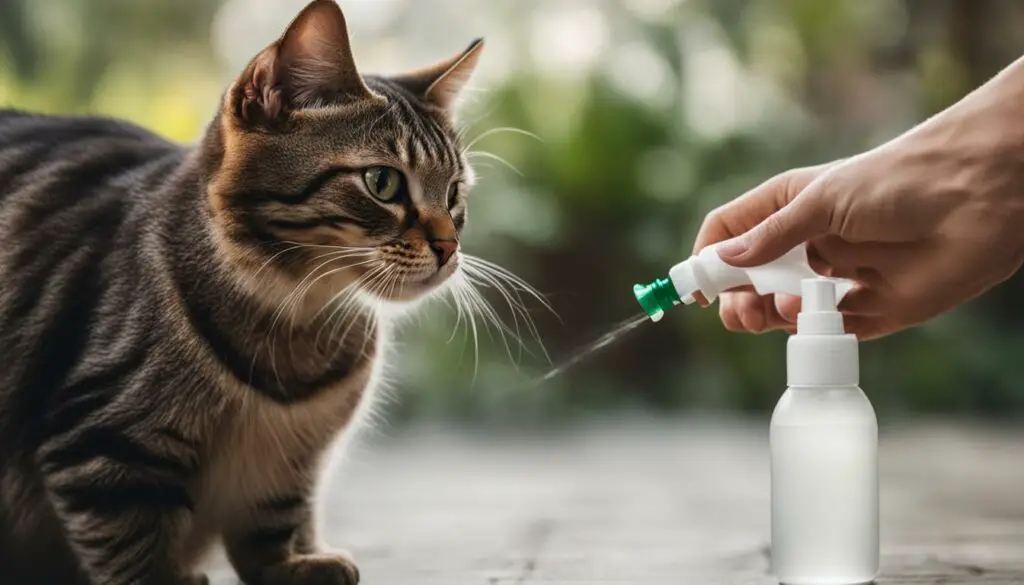
Common Reasons Cats Overgroom Themselves
Overgrooming in cats, which involves excessive licking, chewing, and biting of their own fur, can be a cause for concern among pet owners. There are several common reasons why cats may engage in this behavior, including stress-related issues, medical conditions, and behavioral problems.
One of the main factors that can contribute to overgrooming in cats is stress. Cats are sensitive animals, and situations such as changes in their environment, the introduction of a new pet, or the absence of a familiar family member can lead to stress and anxiety. In response to these emotions, cats may resort to excessive grooming as a way to cope.
Medical conditions can also be a cause of overgrooming in cats. Skin allergies, parasites, infections, or underlying health issues can cause discomfort or itchiness, prompting cats to overgroom in an attempt to alleviate the discomfort. It is important to consult with a veterinarian to properly diagnose and address any potential medical concerns.
In some cases, overgrooming can be a manifestation of underlying behavioral issues. Cats may engage in excessive grooming as a compulsive behavior, similar to human compulsive disorders. This can be triggered by various factors, including boredom, anxiety, or a lack of environmental stimulation. A veterinarian or a licensed feline behaviorist can provide guidance and develop a behavior modification plan to address these issues.
| Common Reasons Cats Overgroom Themselves |
|---|
| Stress-related behavior |
| Medical conditions |
| Behavioral issues |
| Veterinarian guidance |
If your cat is overgrooming, it is essential to seek veterinarian guidance to determine the underlying cause and develop an appropriate treatment plan. This may involve addressing any potential medical issues, implementing behavior modification techniques, and creating an environment that promotes mental and physical well-being for your cat.
By understanding the common reasons behind cat overgrooming and taking proactive steps to address them, you can help ensure the health and happiness of your feline companion.
Potential Health Concerns from Hair Consumption
Cats grooming themselves is a natural behavior, but when it comes to consuming hair, there can be potential health risks to consider. Ingesting excessive amounts of hair can lead to the formation of hairballs in a cat’s digestive system, which may cause intestinal blockages. This can result in discomfort, vomiting, and even require surgical intervention. Additionally, eating hair can be a symptom of a condition called pica, which is characterized by the ingestion of non-food items.
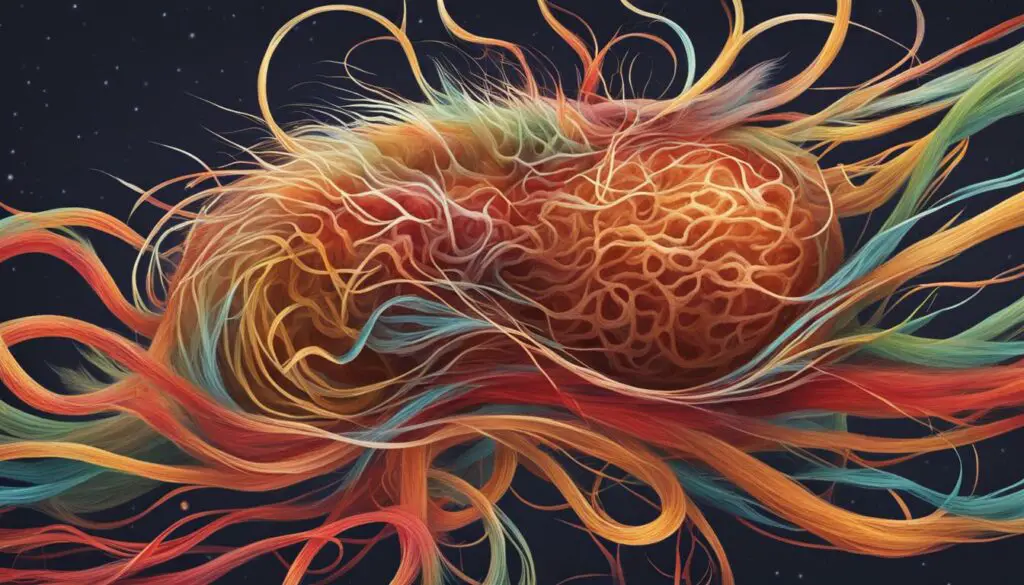
If you suspect that your cat has been consuming an excessive amount of hair or is showing signs of gastrointestinal distress, it is important to seek veterinary evaluation. A veterinarian can assess your cat’s health, perform necessary tests, and provide appropriate treatment options. They can determine if there are any underlying medical conditions contributing to the behavior and develop a plan to address it.
Prevention and management of hair consumption in cats can include regular grooming to minimize shedding and the potential ingestion of loose hairs. Additionally, providing toys and objects for your cat to groom and chew on can redirect their behavior away from hair. Ensuring a safe environment, free from toxic substances and potential hazards, is also essential in preventing health issues related to hair consumption.
Understanding Hair Obsession in Cats
Some cats develop a hair obsession characterized by excessive grooming or chewing of their own hair or the hair of others. This behavior can be a sign of compulsive behavior, and it may be related to underlying medical conditions or behavioral issues. If your cat’s hair obsession becomes a concern, it is advisable to seek professional help from a veterinarian or a licensed feline behaviorist.
Excessive hair grooming in cats, also known as psychogenic alopecia, is a compulsive behavior that can have various underlying causes. Stress and anxiety are common triggers for this behavior, but medical conditions like allergies, fleas, or skin infections can also contribute. Additionally, boredom, environmental changes, or a lack of mental and physical stimulation can lead to the development of hair obsession in cats.
Excessive hair grooming in cats is a complex issue that requires a comprehensive approach to diagnosis and treatment. A feline behaviorist or veterinarian can evaluate your cat’s behavior, medical history, and environment to determine the underlying causes and develop a tailored treatment plan.
Treatment for hair obsession in cats may involve a combination of behavioral modifications, environmental enrichment, and medical interventions. Behavior modification techniques such as providing alternative outlets for grooming, interactive play sessions, and positive reinforcement can help redirect the cat’s obsession. Environmental enrichment, including scratching posts, puzzle toys, and vertical spaces, can also alleviate stress and boredom. In some cases, medication or dietary changes may be recommended to address underlying medical conditions contributing to the behavior.
Table: Common Causes of Hair Obsession in Cats
| Cause | Description |
|---|---|
| Stress and anxiety | Environmental changes, conflict with other pets, or a lack of stimulation |
| Medical conditions | Allergies, fleas, skin infections, or hormonal imbalances |
| Boredom | Lack of mental and physical stimulation |
If your cat exhibits excessive hair grooming, it is essential to consult with a professional to determine the underlying causes and develop an appropriate treatment plan. A feline behaviorist or veterinarian can provide guidance and support to help you address your cat’s hair obsession and improve their overall well-being.
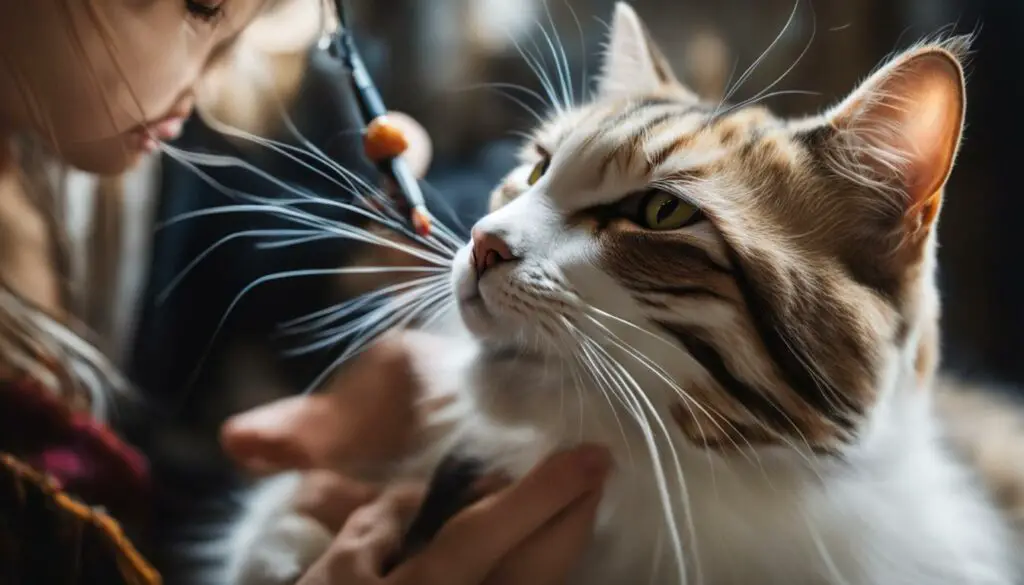
Steps to Redirect Cat Grooming Behavior
If you find that your cat’s hair grooming behavior is becoming too much, there are several steps you can take to redirect their attention and minimize the hair play. By providing alternative toys and objects for your cat to groom, you can give them a suitable outlet for their grooming instincts. Puzzle feeders or cat grass can be great options to keep them engaged.
Using positive reinforcement is also effective in redirecting their grooming behavior. When you see your cat grooming an appropriate item, such as a grooming toy, provide verbal praise or a small treat to encourage them. This positive reinforcement helps them understand what behavior is desired.
Behavior modification techniques can also be used to redirect your cat’s grooming behavior. Consistency is key in training your cat, so make sure to consistently redirect their grooming behavior to the appropriate toys or objects. Avoid punishment or negative reinforcement, as this can lead to increased stress and potentially aggressive behavior.
By following these steps and providing consistent outlets for your cat’s grooming needs, you can successfully redirect their hair grooming behavior and ensure a happy and healthy bond between you and your feline companion.
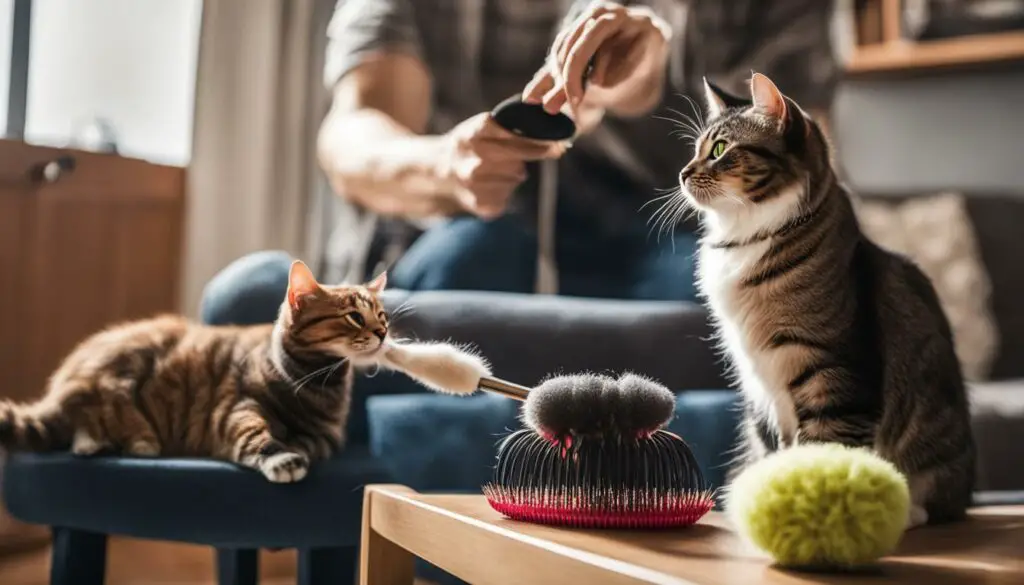
Table: Alternative Toys and Objects for Redirecting Grooming Behavior
| Toy/Object | Description |
|---|---|
| Grooming Toy | A specialized toy designed for cats to groom and chew on, providing a safe and appropriate outlet for their grooming behavior. |
| Puzzle Feeder | A toy that requires your cat to work for their food, stimulating them mentally and physically while keeping them engaged and distracted from grooming hair. |
| Cat Grass | A natural grass that cats can chew on and nibble, mimicking their natural behavior in the wild and providing them with a satisfying alternative to hair grooming. |
The Joy of Affectionate Cat Grooming
When it comes to our furry feline friends, grooming is not just a necessity but also a way to express love and strengthen the bond between cats and their human companions. Affectionate cat grooming, including the act of grooming our hair, is a sign of their love and a form of reciprocal grooming. Just as cats groom each other to enhance their relationships, they extend this behavior to include their favorite humans.
Reciprocal grooming, also known as allogrooming, is a social behavior that helps cats establish and maintain social bonds. By grooming us, cats are showing that they trust and feel comfortable with us. It’s their way of saying, “You’re part of my family.” So, when your cat gently licks your hair, it’s a sign of their affection and a way to further solidify the special bond you share.
“Reciprocal grooming, also known as allogrooming, is a social behavior that helps cats establish and maintain social bonds.”
In addition to being a bonding behavior, affectionate cat grooming through hair play also provides an opportunity for social interaction. As we respond to our cats’ grooming gestures with affection and attention, it reinforces the positive association they have with grooming. It’s their way of seeking and enjoying our company while indulging in their instinctual grooming behaviors.
So, if your cat shows affectionate grooming behaviors like licking your hair, embrace it as a sign of their love and the unique bond you share. Enjoy the special moments of reciprocal grooming as they are a testament to the joy and connection that can be found in the simple act of sharing affection.
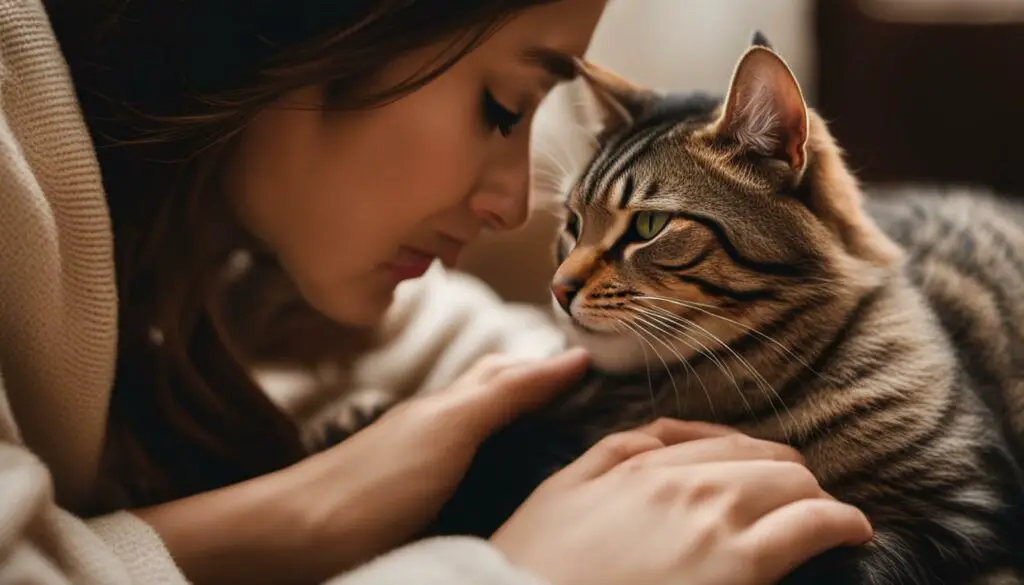
Table: Benefits of Affectionate Cat Grooming
| Benefits | Description |
|---|---|
| Bonding behavior | Affectionate grooming strengthens the bond between cats and their human companions. |
| Reciprocal grooming | Cats groom humans as a way to reciprocate the grooming they receive, enhancing social relationships. |
| Social interaction | Affectionate grooming provides an opportunity for cats and humans to interact and enjoy each other’s company. |
| Signs of love | Grooming behaviors, including hair play, are a clear sign of love and affection from cats. |
How to Enjoy Cat Hair Grooming Safely
When it comes to enjoying the playful hair grooming antics of your feline companion, safety is key. Here are some tips to ensure a safe and enjoyable experience:
1. Gentle Interaction
Engage in gentle interaction when your cat decides to groom your hair. Avoid any rough or forceful movements that may accidentally cause harm. Remember, your cat’s tongue has tiny barbs, so it’s important to be mindful of their delicate skin and hair.
2. Avoiding Ingestion
While it’s normal for your cat to groom your hair, it’s essential to prevent them from ingesting excessive amounts. Ingested hair can lead to the formation of hairballs or even intestinal blockages. If you notice your cat excessively licking or biting your hair, gently redirect their attention to a suitable toy or grooming alternative.
3. Monitoring Hair Consumption
Keep an eye on your cat’s grooming habits and monitor their hair consumption. Excessive hair consumption may indicate an underlying issue or an obsessive grooming behavior. If you notice any significant changes in their grooming patterns or hair consumption, it’s advisable to consult with your veterinarian for guidance.
4. Regular Grooming Routine
Establish a regular grooming routine for your cat to manage their shedding and reduce the need for excessive hair grooming. Use appropriate brushes or combs to help maintain their coat and minimize hair accumulation. Regular grooming sessions not only promote bonding but also help keep your cat’s fur healthy and tangle-free.
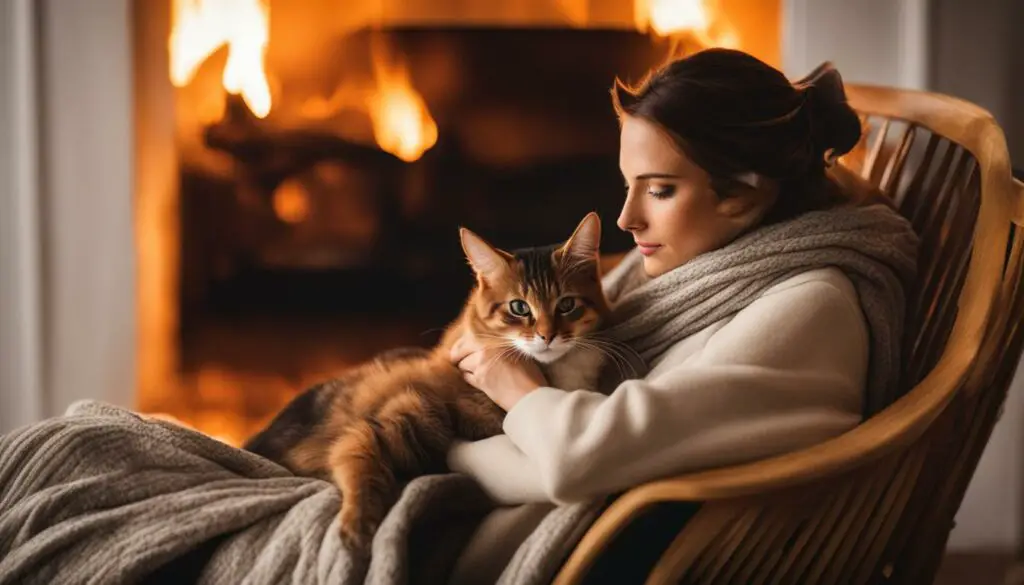
| Safe Enjoyment of Cat Hair Grooming | Tips |
|---|---|
| Gentle Interaction | Engage in gentle interaction when your cat grooms your hair to prevent accidental harm. |
| Avoiding Ingestion | Ensure your cat doesn’t consume excessive amounts of hair to prevent hairballs or blockages. |
| Monitoring Hair Consumption | Keep track of your cat’s grooming habits and watch for any significant changes. |
| Regular Grooming Routine | Establish a consistent grooming routine to manage shedding and maintain a healthy coat. |
The Beauty of Feline Quirks: Embrace the Hair Play
As cat owners, we often encounter the unique and sometimes quirky behaviors of our feline friends. One such behavior is their fascination with playing with human hair. While it may seem strange at first, embracing this behavior can actually strengthen the bond between you and your cat.
Understanding that every cat has individual preferences and quirks is key to fostering a harmonious relationship. Just as each cat has their own personality, they also have their own ways of showing affection. Hair play is one of those ways. So, instead of trying to completely discourage it, why not embrace it as a special part of your cat’s unique character?
Embracing hair play can be a fun and interactive way to engage with your cat. The joy they experience while playing with your hair brings out their playful nature and allows them to express their natural instincts. By allowing them to engage in this behavior, you are fostering a sense of trust and companionship, ultimately strengthening the bond between you and your feline companion.
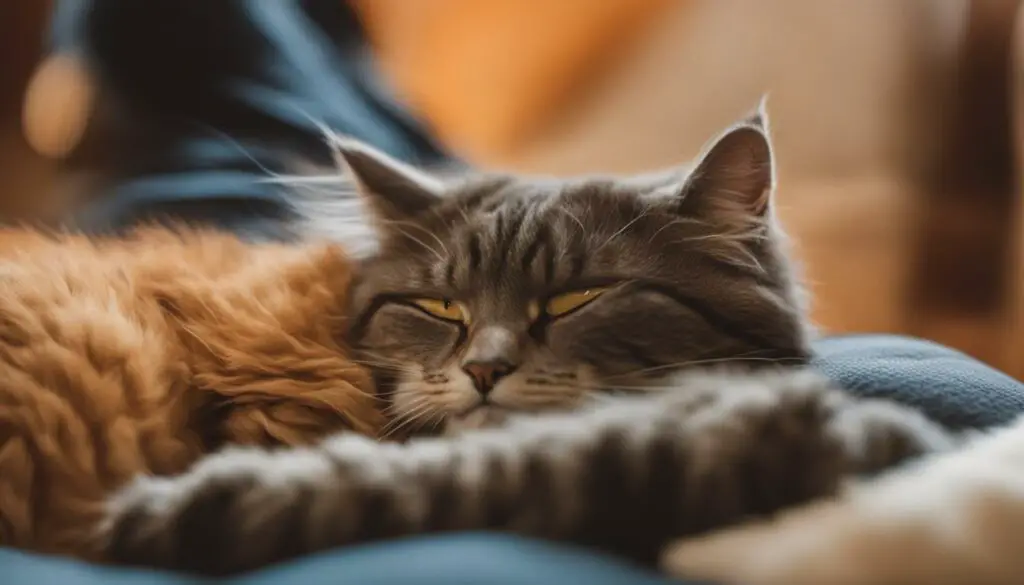
So, next time your cat starts playing with your hair, don’t brush them away or try to redirect their attention. Instead, take a moment to enjoy their quirky behavior and the special connection it brings. Embrace the hair play and let it be a reminder of the unique and beautiful bond you share with your beloved feline friend.
Conclusion
In summary, understanding why cats play with human hair is essential for building a stronger bond with our feline companions. When a cat licks your hair, it’s a sign of affection and a way to reinforce the special connection between you. The rough texture of a cat’s tongue, covered in barbed papillae, helps them groom themselves and remove loose hairs.
Grooming is a vital behavior for cats, serving to keep their fur and skin clean, regulate body temperature, and enhance social bonds. Cats groom each other to mark friendly individuals within their group and avoid aggressive behavior. When cats play with human hair, it’s a result of various factors, including entertainment, grooming instincts, and attraction to scents and textures.
While cat hair play is generally harmless, it’s important to ensure your cat doesn’t ingest excessive amounts of hair or harmful ingredients from hair products. Encouraging appropriate alternatives for grooming, such as toys or designated grooming objects, can help redirect their behavior. Punishing or shouting at your cat for grooming your hair is not advised, as it can lead to stress and behavioral issues.
Embracing and enjoying cat hair play can deepen the bond with your feline friend. By providing a safe and stimulating environment, monitoring their grooming habits, and seeking professional guidance if needed, you can foster a loving and playful relationship with your cat.
FAQ
Why does my cat play with my hair?
Cats play with human hair as a form of bonding, grooming, entertainment, and comfort-seeking. It is a natural behavior influenced by their instinctual and social nature.
What is the significance of cat hair play with humans?
When a cat grooms your hair, it is a sign of affection and an attempt to strengthen their social bond with you by sharing their scent. Cats enjoy the attention you give them in response to their hair-licking behavior.
Why do cats groom each other?
Cats groom each other to enhance their social bonds and exchange scents. Allogrooming focuses on the head and neck area, which contains scent glands that secrete pheromones. Licking and rubbing these areas helps mark and reaffirm members of their group.
Is it safe for cats to groom human hair?
Licking human hair doesn’t usually carry any health concerns for cats unless they are eating the hair or ingesting harmful ingredients from hair or skin products. Eating hair can potentially lead to the formation of hairballs in the cat’s digestive system, which may require surgical removal.
How can I discourage cat hair grooming?
If you don’t enjoy it when your cat grooms your hair, you can try changing the scent of your hair products or using distracting techniques such as playtime or toys. Ignoring the behavior or redirecting their grooming behavior to appropriate toys or objects can also be effective.
Why do cats overgroom themselves?
Cats may start grooming themselves excessively for various reasons, including stress, medical conditions, or behavioral issues.
What are the potential health concerns from hair consumption?
While small amounts of hair ingestion are usually harmless, consuming excessive amounts of hair can lead to the formation of hairballs in the cat’s digestive system. These hairballs may cause intestinal blockages and may require immediate surgical intervention.
What is hair obsession in cats?
Some cats may develop a hair obsession characterized by excessive grooming or chewing of their own hair or the hair of others. This behavior can be a sign of a compulsive disorder and may be related to underlying medical conditions or behavioral issues.
How can I redirect cat grooming behavior?
To redirect your cat’s grooming behavior, provide alternative toys and objects for them to groom, such as puzzle feeders or cat grass. Use positive reinforcement to reward and encourage grooming appropriate items instead of hair. Consistency in training and providing ample outlets for your cat’s grooming needs are essential.
How can I enjoy cat hair grooming safely?
To safely enjoy cat hair grooming, ensure gentle interaction to prevent accidental ingestion of hair. Monitor the amount of hair your cat consumes and be aware of any changes in their grooming habits. Regular grooming sessions, using appropriate brushes or combs, can help manage shedding and minimize the need for excessive grooming behavior.
Should I embrace cat hair play?
Rather than trying to completely discourage cat hair play, embrace it as a unique and quirky behavior of your feline friend. Understanding and accepting individual preferences can strengthen the bond between you and your cat. As long as the behavior is not causing harm or distress, allowing your cat to engage in hair play can add a sense of joy and playfulness to your relationship.

